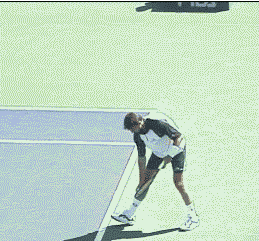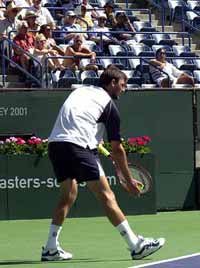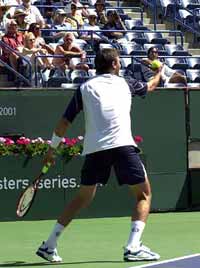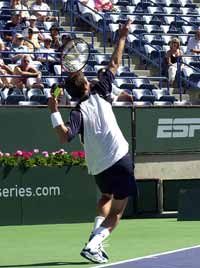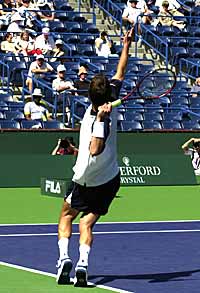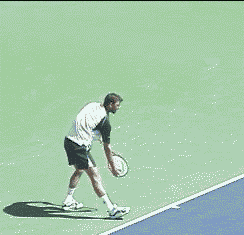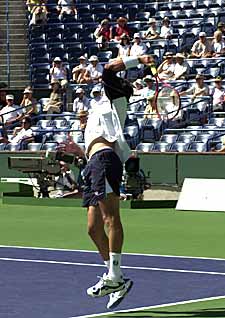|
TennisOne Lessons
Goran the Resilientby Jim McLennan
Throughout his roller coaster career, Goran Ivanisevic has climbed the heights, sunk to unbelievable depths, and now, at this years amazing Wimbledon championships, scaled the mountain yet again. Through all the near misses (three Wimbledon finals), unusual shot-making, and strategic lapses, he has hung around, kept at the circuit despite a severe shoulder injury and a string of first round losses in the past 18 months, and now holds the Wimbledon title. Goran the Resilient. A one shot wonder (as labeled by McEnroe) his serve is a remarkable weapon, somewhat reminiscent of Roscoe Tanner's, and well worth a few words of analysis. For those who do not remember, Roscoe had a huge lefty delivery, he once broke the net with a serve at the US Open upsetting no less than Bjorn Borg in the process. Roscoe had a quick motion, a low toss, and a huge snap at the top of the swing. Right-handed versions of this type of delivery include Kevin Curren, but I am stumped to find a modern version of this type of serve. FeetGoran starts with a wide stance, and shifts his back forward with the toss. He repositions the back foot to form a pinpoint stance, and then shifts his weight so that both legs plant and both legs then drive the motion.
HipsGoran starts with the hips sideways to the net, not nearly as far around as Sampras or McEnroe. As he moves his feet and then his body into the hit, notice the hips remain initially quiet, no additional reverse coil, but certainly after the dual leg drive the hips unwind into the hit.
ShouldersNow it starts to get interesting. At the address, his hips and shoulders are in line, both somewhat sideways to the net. As he shifts forward notice the shoulders coil backward, drawing the left shoulder and elbow away from the ball. This stretch between the sideways hips and more than sideways shoulders forms the rubber band like recoil into the hit. ArmAll the great servers whip the racquet, Goran is no exception. To obtain tremendous racquet head speed, the racquet must be whipped not stroked. Recall popping a wet towel in the locker room (and hopefully this memory is of snapping the towel rather than having been snapped) one swings the towel loosely and then abruptly stops the hand to snap the towel. Similarly, in this instance one swings the racquet in a long and loose arc and then abruptly stops the hand to snap the racquet. Notice how much Goran's arm turns at the top of the swing. You can isolate a picture where his hand is near the top of the swing, yet the racquet head is back so as to clearly see the "Head" insignia. Within a few short frames his hand is still up but slightly in front, yet the racquet has snapped entirely through. And this is the signature of Tanner, Sampras, Curren, McEnroe and only a few of the truly great servers. Not Currier, not Agassi, not Phillipousis (yes this big guy could truly serve a lot better), not Navratilova, not Evert, and not Kournikova.
Momentum Into the CourtObserving the torso and both shoulders as Goran turns into the ball, his upper body carries him well into the court, and just as easily well into the net on serve and volley. Further, his toss is low enough that there is no pause in the delivery, and no interruption of his momentum into the hit and then into the court. In the August 7th issue of Tennis Week, Vic Braden "debunks" the so-called myth of scratching ones back on the serve. He states that the pitcher points the elbow at the batter, whereas many servers merely get their elbow up but not forward. This is a tricky yet important point. Braden states that pointing the elbow forward enables up to 180 degrees of inward shoulder and arm rotation, whereas pointing the elbow up limits the rotation (and resulting power) to 30 or 40 degrees rotation.
Now revisit Goran once again. Look for the position where the racquet has dropped low and away from his body, also known as a "swinging drop" to imply that the racquet must swing through this area. The key frame occurs where the hitting elbow is forward yet the racquet is still back. This is the key to Goran's loose and whip like delivery. Try This at HomeStart with the weight back. Move forward with the toss. Reposition the back foot so it is weighted and so both legs can drive the serve. As you move forward, turn your shoulders away from the ball, keeping the arm loose and the elbow low. As you turn into the hit, uncoil from the ground up, where the leg drive precedes the hips, the hips precede the shoulders, the shoulders precede the arm, and the arm precedes the racquet. Toss the ball somewhat low and well into the court. As you unwind move beneath the ball so contact is above. And finally snap the racquet with a loose whip like feel. In many ways, the grip you use will determine whether you can feel the loose whip like service action. Place your hand low on the handle, even to the point where your little finger is off the end of the butt cap. Grip the racquet with a continental or eastern backhand grip. In the swinging drop (photo above), notice how the edge of the racquet is leading. The key to the whip is as follows: as the racquet approaches the ball, edge still leading, when the arm decelerates the racquet is whipped into the ball, but at this moment the arm turns in, sometimes called pronation. This final snap is the signature of the whip like finish, nicely emphasized in the first animation. Your comments are welcome. Let us know what you think about Jim McLennan's article by emailing us here at TennisOne.
|
||||||||||||||||||||

